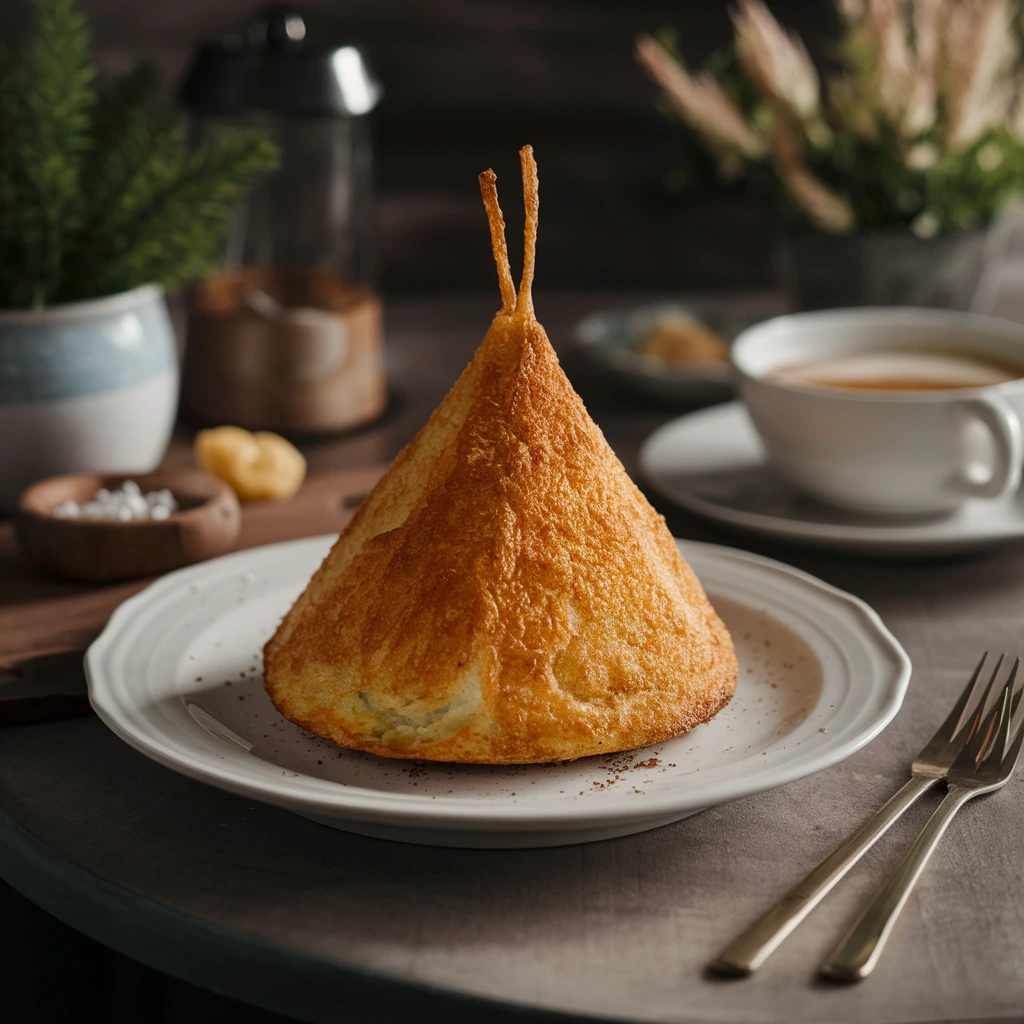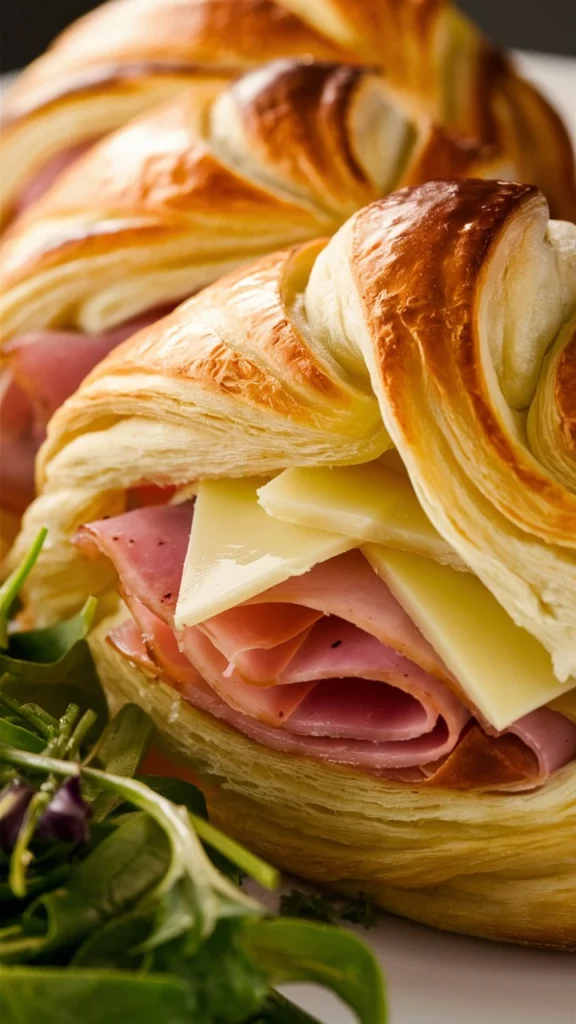Gipfeli recipe: 5 Proven Tips for Flaky Perfection

What is Gipfeli Recipe?
Imagine waking up to the aroma of freshly baked pastries, their golden layers glistening with a light dusting of powdered sugar. This is the magic of gipfeli, the Swiss cousin of the French croissant. Originating in Switzerland, gipfeli (pronounced “gip-feh-lee”) is a buttery, flaky pastry that has become a breakfast staple across the country. Unlike its French counterpart, gipfeli often features a slightly denser texture and a more pronounced buttery flavor, making it a unique treat for pastry lovers.
The origins of gipfeli trace back to the 19th century when Swiss bakers began experimenting with laminated dough techniques inspired by French bakers. However, the Swiss added their own twist, using locally sourced butter and milk to create a richer, more indulgent pastry. Traditionally, gipfeli is enjoyed plain or filled with chocolate, almond paste, or even ham and cheese for a savory twist. Regional variations abound, with some bakers adding a hint of vanilla or citrus zest to the dough for an extra layer of flavor.
Key ingredients include high-quality butter, flour, yeast, and a touch of sugar. The secret to its flaky layers lies in the meticulous process of folding and rolling the dough, a technique that requires patience and precision. Whether you’re a seasoned baker or a curious beginner, mastering the gipfeli recipe is a rewarding journey that connects you to a rich culinary tradition. For more inspiration, check out our Homepage for other delightful recipes.
Mastering Gipfeli Recipe at Home
Creating gipfeli at home may seem daunting, but with the right tools and techniques, you can achieve bakery-quality results. Start with a sturdy rolling pin, a sharp knife, and a reliable oven thermometer to ensure even baking. The dough requires a cool environment, so keep your kitchen temperature low or work in short bursts to prevent the butter from melting prematurely.
Essential Tools and Techniques
Laminated dough is the heart of gipfeli, and mastering it is key to achieving those signature flaky layers. Begin by preparing a simple yeast dough, then encase a block of cold butter within it. Roll out the dough, fold it into thirds, and repeat the process several times. This technique, known as “turning,” creates the delicate layers that puff up during baking. Pro tip: Chill the dough between folds to maintain the butter’s firmness and prevent it from seeping out.
Flavor-Enhancing Tricks
While traditional gipfeli relies on the natural richness of butter, you can elevate the flavor by experimenting with additions like vanilla bean paste, orange zest, or a sprinkle of cinnamon. For a savory twist, try incorporating grated cheese or herbs into the dough. When baking, brush the pastries with an egg wash for a glossy, golden finish. And don’t forget to let them cool slightly before serving—this allows the layers to set and enhances the texture.
Time-Saving Methods
If you’re short on time, consider preparing the dough the night before and refrigerating it overnight. This not only saves time but also enhances the flavor as the dough develops. Alternatively, you can freeze the shaped pastries before baking and bake them straight from the freezer for a fresh, on-demand treat. With a little practice, you’ll find that making gipfeli at home is not only achievable but also deeply satisfying.
Whether you’re savoring a warm gipfeli with your morning coffee or sharing a batch with friends, this Swiss delicacy is sure to impress. Dive into the world of gipfeli and discover why this pastry has captured hearts for generations. For more culinary adventures, explore our Homepage and let your kitchen become a canvas for creativity.
Table of Contents
📜 Historical Information
Gipfeli, the Swiss version of the French croissant, originated in Switzerland and has become a beloved breakfast staple across the country. Known for its flaky, buttery layers, this pastry reflects Switzerland’s rich baking traditions and its cultural ties to neighboring France. Over time, gipfeli has evolved to include modern variations, from savory fillings to sweet glazes, making it a versatile treat for any occasion.
🥕 What You’ll Need
Here’s everything you need to make 4 servings of authentic gipfeli:
- 500g all-purpose flour (use high-protein flour for better texture)
- 250g unsalted butter (cold, high-quality butter ensures flakiness)
- 10g salt (fine sea salt works best)
- 50g sugar (optional, for a slightly sweet version)
- 250ml cold milk (whole milk adds richness)
- 7g active dry yeast (or instant yeast for quicker proofing)
- 1 egg (for egg wash, to achieve a golden crust)

Health Benefits of Key Ingredients
- Butter: Rich in vitamins A and D, butter supports bone health and boosts immunity. Opt for grass-fed butter for added omega-3 fatty acids.
- Flour: Provides essential carbohydrates for energy. Whole-grain flour alternatives can increase fiber content for better digestion.
Nutrition Facts (Per Serving)
| Calories | Protein | Fat | Carbohydrates |
|---|---|---|---|
| 320 kcal | 6g | 18g | 35g |
👩🍳 Cooking Instructions
Gipfeli recipe: 5 Proven Tips for Flaky Perfection
12
servings1
hour20
minutes250
kcal1
hour20
minutesIngredients
- Dough
3 cups all-purpose flour
1/4 cup granulated sugar
1 packet (2 1/4 tsp) active dry yeast
3/4 cup warm milk (110°F/45°C)
1/2 cup unsalted butter, softened
1/2 teaspoon salt
1 large egg
- Butter Layer
1 cup unsalted butter, cold
2 tablespoons all-purpose flour (for dusting)
- Egg Wash
1 egg yolk
1 tablespoon milk
Directions
- Preparation
- Warm the milk to 110°F (45°C) and dissolve the sugar and yeast in it. Let it sit for 5-10 minutes until foamy.
- In a large bowl, combine the flour and salt. Add the yeast mixture, egg, and softened butter. Knead for 8-10 minutes until smooth and elastic.
- Cover the dough and let it rise in a warm place for 1-2 hours or until doubled in size.
- Butter Layer
- Place the cold butter between two sheets of parchment paper.
- Roll the butter into a flat rectangle (about 8×8 inches) and refrigerate until firm.
- Laminating the Dough
- Roll out the dough on a floured surface into a 12×16 inch rectangle.
- Place the butter layer in the center of the dough and fold the sides over it to encase the butter completely.
- Roll the dough into a long rectangle and fold it into thirds. Refrigerate for 30 minutes.
- Repeat the rolling and folding process two more times, chilling the dough between each fold.
- Shaping the Gipfeli
- Roll the dough into a large rectangle (about 1/4 inch thick).
- Cut the dough into triangles (about 4 inches wide at the base).
- Roll each triangle tightly from the base to the tip to form the classic Gipfeli shape.
- Place the shaped Gipfeli on a lined baking sheet, cover lightly, and let them rise for 45 minutes until puffy.
- Baking
- Preheat your oven to 375°F (190°C).
- Brush each Gipfeli with egg wash for a golden finish.
- Bake for 18-22 minutes or until golden brown and flaky.
- Cooling and Serving
- Allow the Gipfeli to cool on a wire rack for 10 minutes before serving.
- Enjoy fresh with butter, jam, or your favorite filling!
1. Prep Work
Gather your tools: a rolling pin, baking sheet, parchment paper, and a sharp knife. Start by activating the yeast in warm milk (around 37°C) with a pinch of sugar. Let it sit for 5-10 minutes until frothy. Meanwhile, mix the flour, salt, and sugar in a large bowl.
2. Core Technique Walkthrough
Add the yeast mixture to the dry ingredients and knead until a smooth dough forms. Roll the dough into a rectangle and place the cold butter in the center. Fold the dough over the butter, sealing it completely. Roll out the dough again, fold it into thirds (like a letter), and chill for 30 minutes. Repeat this process 3-4 times to create layers.
3. Doneness Indicators
After shaping the gipfeli into crescents, brush them with egg wash and bake at 200°C for 15-20 minutes. They’re done when golden brown and flaky, with a hollow sound when tapped on the bottom.
4. Pro Preservation Method
Store gipfeli in an airtight container at room temperature for up to 2 days. For longer storage, freeze them in a sealed bag and reheat in the oven at 180°C for 5-7 minutes.
🌍 Creative Variations
Dietary Needs
For a vegan version, replace butter with plant-based margarine and use almond milk instead of dairy. Swap the egg wash with a mix of maple syrup and water for a glossy finish.
Regional Flavors
Add a Tex-Mex twist by filling the dough with shredded cheese and jalapeños before baking. For a Mediterranean flair, sprinkle za’atar and olive oil on top.
Seasonal Ingredients
Incorporate seasonal fruits like apples or berries into the filling for a sweet variation. During the holidays, add cinnamon and nutmeg for a festive touch.
Tips for Perfect Gipfeli
- Keep the butter cold at all times to ensure flaky layers.
- Don’t rush the chilling process—patience is key to achieving the perfect texture.
- Use a sharp knife or pizza cutter to shape the dough cleanly.
With this gipfeli recipe, you’ll bring a taste of Switzerland to your kitchen. Whether enjoyed plain or with creative twists, these pastries are sure to impress!
Insider Techniques for the Perfect Gipfeli
Creating the perfect gipfeli requires a blend of precision, patience, and a few professional tricks. Here are three rarely-shared methods to elevate your gipfeli game:
Texture Mastery: Crispy and Tender Balance
To achieve the ideal balance between a crispy exterior and a tender, flaky interior, start with cold butter. The key is to keep the butter cold throughout the process. Use a technique called “laminating,” where you fold the dough multiple times to create layers. This ensures that when the gipfeli bakes, the butter melts and creates steam, resulting in those coveted flaky layers. Additionally, chilling the dough between folds prevents the butter from melting prematurely.
Flavor Layering: Herb and Spice Timing
Timing is everything when it comes to adding herbs and spices. Incorporate dried herbs like thyme or rosemary into the dough during the initial mixing stage. For fresh herbs, such as parsley or chives, add them just before the final fold to preserve their vibrant flavor. Spices like nutmeg or black pepper should be added sparingly and mixed into the dough early on to allow their flavors to meld seamlessly.
Time-Saving Prep Hacks
To save time, prepare the dough the night before and let it rest in the refrigerator overnight. This not only enhances the flavor but also makes the dough easier to handle. Another hack is to use a food processor to cut the butter into the flour quickly, ensuring even distribution without overworking the dough. Pre-measuring all your ingredients before starting can also streamline the process.
Storage Instructions for Gipfeli
Proper storage is crucial to maintaining the freshness and quality of your gipfeli. Here’s how to store them for both short-term and long-term use:
Short-Term Storage (Up to 3 Days)
For short-term storage, place the gipfeli in an airtight container lined with parchment paper to prevent them from sticking together. Store them at room temperature, away from direct sunlight. If you prefer a slightly warmer gipfeli, you can reheat them in a preheated oven at 350°F (175°C) for 5-7 minutes before serving.
Long-Term Storage (Up to 3 Months)
For long-term storage, freeze the gipfeli individually on a baking sheet until solid, then transfer them to a freezer-safe bag or container. When ready to serve, bake them directly from the freezer at 375°F (190°C) for 10-12 minutes, or until golden brown and heated through.
Revival Techniques for Dried-Out Portions
If your gipfeli have dried out, revive them by lightly brushing the surface with melted butter or milk and reheating them in the oven at 350°F (175°C) for a few minutes. This will help restore their moisture and bring back their flaky texture.
Plate Perfection: Serving Secrets
Presentation is key when serving gipfeli. Here are some tips to make your gipfeli look as good as they taste:
Occasion-Based Presentation
For casual gatherings, serve gipfeli on a rustic wooden board with a variety of dips and spreads. For a more gourmet presentation, arrange them on a sleek platter with edible flowers and fresh herbs for a pop of color. Consider serving them in a basket lined with a linen napkin for a touch of elegance.
Garnish Pairings
Enhance the visual appeal of your gipfeli with garnishes like fresh herbs, edible flowers, or a light dusting of powdered sugar. Pair them with complementary flavors such as a sprinkle of sea salt or a drizzle of honey for a sweet and savory contrast.
Temperature Control During Service
To ensure your gipfeli are served at the perfect temperature, keep them warm in a low oven (around 200°F or 95°C) until ready to serve. If serving cold, make sure they are at room temperature to allow the flavors to shine.
Fix Common Issues: Troubleshooting Toolkit
Even the best chefs encounter challenges. Here’s how to fix common gipfeli issues:
Over-Seasoning Fixes
If you’ve over-seasoned your gipfeli, balance the flavors by adding a neutral element like unsalted butter or a plain cream cheese spread. You can also serve them with a mild dip, such as a yogurt-based sauce, to counteract the strong seasoning.
Texture Rescue Methods
If your gipfeli turn out too dense, ensure you’re not overworking the dough. Over-kneading can develop too much gluten, resulting in a tough texture. For a lighter texture, try adding a bit more butter or using a higher-protein flour.
Flavor Balancing Acts
If the flavors in your gipfeli are unbalanced, adjust by adding a contrasting element. For example, if the gipfeli are too sweet, add a pinch of salt or a squeeze of lemon juice to balance the sweetness. Conversely, if they’re too savory, a touch of honey or a sprinkle of sugar can help.
Harmonious Combinations: Pairing Matrix
Pairing your gipfeli with the right accompaniments can elevate the dining experience. Here are some suggestions:
Beverage Pairings
For a classic pairing, serve gipfeli with a crisp white wine like Sauvignon Blanc or a light beer such as a pilsner. Non-alcoholic options include sparkling water with a twist of lemon or a refreshing iced tea.
Side Dish Pairings
Complement your gipfeli with side dishes that offer a contrast in texture and flavor. Consider a fresh green salad with a tangy vinaigrette or a creamy potato salad. For a heartier option, pair them with roasted vegetables or a rich quiche.
Sauce Pairings
Enhance your gipfeli with a variety of sauces. A creamy hollandaise or a tangy aioli can add richness, while a spicy mustard or a sweet fruit compote can provide a delightful contrast. Experiment with different combinations to find your perfect match.
By following these expert tips and techniques, you’ll be well on your way
❓ FAQ Framework ❓
Welcome to the Gipfeli Recipe FAQ section! Here, we address your most common questions about making the perfect Gipfeli, from ingredient flexibility to time-saving tips and flavor customization. Dive in to find answers tailored to your needs.
Q: What is the difference between a croissant and a gipfeli?
Although both have a crescent shape, the French croissant is made with a high butter content resulting in a light, flaky, and airy texture. In contrast, the Swiss gipfeli is typically denser, made with less butter, and often has a slightly sweeter flavor.
Q: What is the secret to a good croissant?
The key is in the lamination process—repeatedly folding high-quality butter into the dough to create multiple thin layers. Proper dough fermentation and precise temperature control are also essential for achieving the perfect flaky and flavorful croissant.
Q: What ingredients are in a croissant?
Traditional croissants consist of simple ingredients: flour, water, sugar, salt, yeast, and plenty of butter. Some recipes may also include milk or egg to enrich the dough.
Q: What are the ingredients in Nussgipfel?
Nussgipfel, the nut-filled variant of gipfeli, uses the same basic ingredients as a traditional gipfeli but adds ground nuts (commonly hazelnuts or walnuts), sugar, and sometimes almond paste to create a rich, nutty filling.
Ingredient Flexibility of Gipfeli Recipe
Explore substitutions for:
Whether you’re dealing with dietary restrictions, regional ingredient availability, or simply want to experiment with flavors, the Gipfeli recipe is highly adaptable. Here are some suggestions:
- Dietary Restrictions: For a vegan version, replace butter with plant-based margarine and use a non-dairy milk. For gluten-free Gipfeli, opt for a gluten-free flour blend.
- Regional Ingredient Availability: If you can’t find European-style butter, use regular unsalted butter. For yeast, active dry yeast can substitute fresh yeast.
- Flavor Profile Alternatives: Swap traditional fillings like chocolate or jam with savory options like cheese or herbs for a unique twist.
Troubleshooting Guide
Address common issues like:
Even experienced bakers encounter challenges. Here’s how to troubleshoot common Gipfeli problems:
- Texture Problems: If your Gipfeli is too dry, brush the dough with milk before baking. If it’s too moist, reduce the liquid in the dough or bake slightly longer.
- Flavor Balancing: Over-seasoned dough? Balance it with a neutral filling like plain chocolate or cheese.
- Cooking Time Adjustments: If your Gipfeli browns too quickly, lower the oven temperature by 10°C and extend the baking time.
Make-Ahead Strategies
Detail methods for:
Save time without compromising quality with these make-ahead tips:
- Partial Prep: Prepare the dough the night before and refrigerate it. Shape and bake the Gipfeli fresh in the morning.
- Full Recipe Freezing: Freeze unbaked Gipfeli on a baking sheet, then transfer to a freezer bag. Bake directly from frozen, adding a few extra minutes to the cooking time.
- Storage Timelines and Reheating Tips: Store baked Gipfeli in an airtight container for up to 2 days. Reheat in a 180°C oven for 5 minutes to restore crispiness.
Health-Conscious Options
Provide alternatives for:
Enjoy Gipfeli while staying mindful of your health goals:
- Lower Calorie Versions: Use a light butter substitute and reduce sugar in the dough.
- Macronutrient Adjustments: For a low-carb version, use almond flour and a sugar substitute. For high-protein Gipfeli, add a scoop of protein powder to the dough.
- Allergen-Free Variations: Replace nuts in fillings with seeds like sunflower or pumpkin for a nut-free option.
Taste Personalization
Suggest modifications for:
Customize your Gipfeli to suit your taste preferences:
- Spice Level Adjustments: Add cinnamon or cardamom to the dough for a warm, spiced flavor.
- Regional Flavor Influences: Incorporate local ingredients like matcha powder for a Japanese twist or dulce de leche for a South American flair.
- Kid-Friendly Adaptations: Use fun shapes and colorful fillings like sprinkles or fruit preserves to make Gipfeli appealing to children.
Key Takeaways of Gipfeli Recipe
Congratulations! You’ve just unlocked the secrets to making the perfect gipfeli, a Swiss-inspired pastry that’s as delightful to bake as it is to eat. Let’s recap what makes this recipe so special:
- Essential Techniques Mastered: From laminating the dough to achieving that golden, flaky crust, you’ve learned the art of creating layers that melt in your mouth.
- Special Ingredients Highlighted: The combination of high-quality butter and a touch of honey elevates this recipe, giving it a rich, indulgent flavor.
- Cultural Significance Explored: Gipfeli, or Swiss croissants, are more than just pastries—they’re a symbol of Swiss breakfast culture, bringing warmth and joy to every bite.
Your Culinary Journey Starts Here
Now that you’ve mastered the gipfeli recipe, it’s time to put your skills to the test! Here’s how you can take the next step:
- Try the Recipe This Week: Gather your ingredients, roll up your sleeves, and bake a batch of gipfeli. Trust us, the aroma alone is worth it!
- Share Your Creations Online: Snap a photo of your golden, flaky pastries and share them with the world. We’d love to see your masterpiece!
- Tag @Smokerrecipes for Feedback: Don’t forget to tag us on Instagram so we can cheer you on and share your work with our community.
Join Our Foodie Family
Baking is always better when shared with others. Let’s stay connected and keep the inspiration flowing:
• Follow on Instagram: Get daily inspiration, behind-the-scenes tips, and mouthwatering recipes by following @Smokerrecipes.
• Explore Pinterest Boards: Dive into our curated boards for more dessert ideas, seasonal recipes, and creative plating tips.
• Join Our Facebook Group: Connect with fellow foodies, share your cooking triumphs, and get advice in our friendly Facebook community.
Expand Your Skills
Ready to take your baking to the next level? Here are some ideas to keep your culinary journey exciting:
- Related Recipes to Try: Experiment with other laminated dough recipes like Danish pastries or pain au chocolat.
- Seasonal Variations to Explore: Add a twist to your gipfeli by incorporating seasonal flavors—think pumpkin spice in the fall or fresh berries in the summer.
- Cooking Challenges to Attempt: Push your skills further by attempting a multi-day sourdough croissant recipe or hosting a bake-off with friends.
Remember, every great baker started with a single recipe. Whether this is your first time making gipfeli or you’re a seasoned pro, we’re so proud of you for taking this step. Keep baking, keep sharing, and most importantly, keep enjoying the process. Happy baking!





